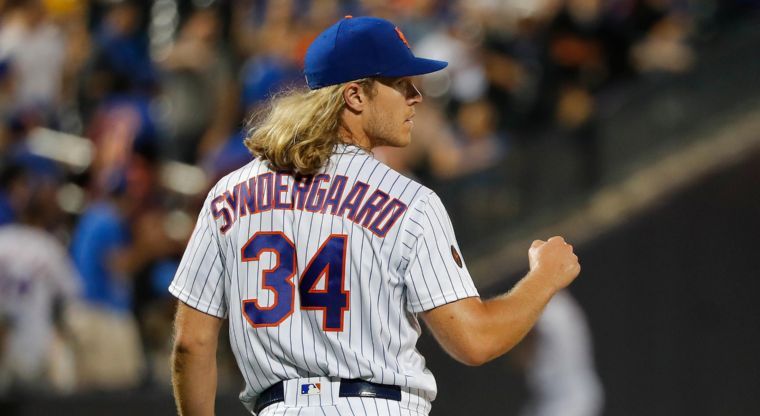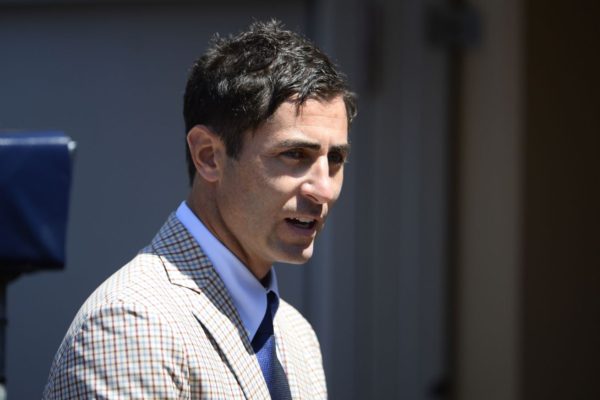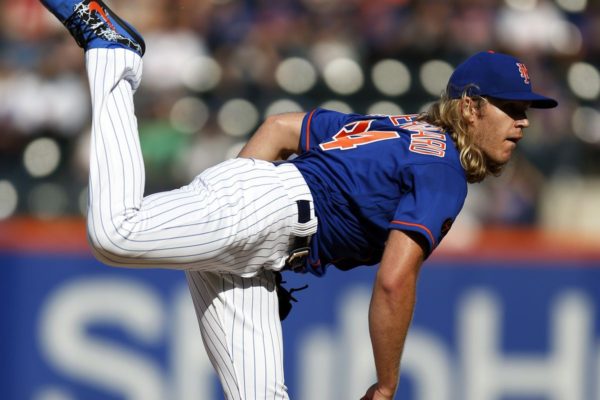Noah Syndergaard and the 2020 Padres

Credit: AP Photo

This is purely hypothetical, but let’s say the San Diego Padres trade Luis Urías (MLB.com #18 prospect) and Michel Baez (MLB.com #69 prospect) to the New York Mets for Noah Syndergaard.
The Padres would now enter 2020 with a starting rotation of Chris Paddack, Garrett Richards, Syndergaard, Cal Quantrill, and Joey Lucchesi. Top pitching prospects MacKenzie Gore (#3, age 20), Adrian Morejon (#47, age 20), Ryan Weathers (#70, age 19), and Logan Allen (#73, age 22) are still with the team, as well as Xavier Edwards (#87, age 19).
Syndergaard needs to improve on his 4.33 ERA to be worth the trade. His FIP of 3.64 indicates that he is poised to improve, though his xFIP of 4.03 suggests that this will be slight. With Austin Hedges framing his pitches, and Fernando Tatis and Manny Machado playing stellar defense behind him, Syndergaard could certainly give up fewer runs. ZIPS predicted a 3.40 ERA, 3.18 FIP in 2019. While Syndergaard fell short of those predictions, a sub 4.00 ERA is a reasonable expectation. This is a vast improvement over the 5.42 ERA of Matt Strahm and 6.41 ERA of Nick Margevicius over a combined 27 starts.
Projected to pitch about 180 innings this season, Syndergaard is a strong arm who can go deep into games. He’s averaging over six innings per start and giving up less than a home run per nine innings pitched, fewer than Paddack (1.4), Lucchesi (1.2), or Quantrill (1.2). The improvement is far better than the rates for Matt Strahm (2.1) and Margevicius (2.0). Taking those innings from Strahm allows for another option out of the bullpen, where Strahm is significantly better (1.59 ERA, 0.706 WHIP in 5.2 innings this season; 2.46 ERA 1.135 WHIP career as a reliever). By adding Syndergaard, the Padres improve their bullpen by being able to commit Strahm and Allen to the bullpen. This may also free the team to deal Kirby Yates at the deadline.
With the deep farm system, the Padres are only impacted at second base with this proposed deal. While Greg Garcia can play well enough to get the Padres through the end of 2019, Ian Kinsler has faded fast and is unlikely to make the cut next year if the team intends on competing. To fill the hole, the Padres could go after a free agent if they move Wil Myers and a portion of his $20 million a year salary or they could look at promoting another prospect. The more likely of the options for San Diego is to dip into their vast wealth of middle-infield prospects to plug the hole.
A long shot would be Xavier Edwards, a 2018 conditional-round pick who has been playing some second base at Fort Wayne. Edwards turns 20 in two weeks and started 13 of 14 games at second base after his promotion to High-A Lake Elsinore. At Triple-A El Paso, 27-year-old Esteban Quiroz is flashing a lot of power (.543 SLG) and could be an option. The Sod Poodles have younger second basemen: Ivan Castillo and Owen Miller, but neither has the flashy numbers that Urías showed in the minors.

Syndergaard has fWAR of 2.7 in 120 innings, over 180 innings, he could be a 4 WAR pitcher for the Padres. Strahm has 0.3 fWAR in 85 innings. If he managed 170 innings next year as a starter, he’d be worth about 0.6 fWAR, an improvement of 3.4. ZIPS predicted Urías at 0.4 fWAR over 160 at-bats, a full season would make that about 1.2 fWAR, and likely an improvement next year. Greg Garcia has 1.1 fWAR in 216 plate appearances this year, which would be close to 3 fWAR over a full season, so the Padres don’t lose much if any in the near-term going forward if they replace Urías with Garcia and add Syndergaard over Strahm in the rotation (plus add Strahm to the bullpen where he is more effective). Strictly in terms of fWAR, Garcia and Syndergaard could be +2 wins for the rest of this year, and +6 combined next year.
Financially, the 2020 Padres need to pay for Syndergaard who makes $6 million this year and is due for a raise as he is arbitration-eligible in 2020. However, as he is not a free agent until the 2022 season, the Padres would have two and one-half years of control. While the Padres do not appear to have a lot of room on their payroll, there will likely be a corresponding move, such as trading Kirby Yates at the deadline and using a cheaper option at closer in 2020. Considering that Yates has been worth 2.5 fWAR and Trey Wingenter is worth 0.5 in a comparable number of innings, the advantage of Syndergaard is lessened. However, compared to the cost of acquiring a top of the rotation arm in free agency, trading for Syndergaard saves the Padres a significant amount, even if his arbitration number is $10 million to $15 million each of the next three years. The Padres could also look to trade Yates for a prospect to replace Urías as a long-term solution at second base.
A final angle of this hypothetical is a three-team trade: Yates goes to the third team, Syndergaard to the Padres, the third team adds prospects to the group of prospect the Padres send to the Mets. Such a trade could see the Padres keeping Urías and adding a less valuable trade piece.
Stay Tuned.
Hi anything to get the Mets pitcher is in my opinion a great move however I would caution the padres players not to let Kirby Yates go until you get a closer for the padres. We need to really think about all the current needs that the team needs now!!!!!!
Im patient, if you can trade Myers and Margevicius for Syndergaard. I think it’s a Good deal, as Syndergaard has had injury issues.
Why in the world would the Mets make that trade? neither Myers or Margevicius have any trade value.
Danny. This was a fabulous article. You broke down the club’s complete farm system and weaved it into how the club moves forward. You made a great case for taking the chance of adding Syndergaard’ s potential to make them a great club and his maturity should help those young pitchers. I d love to get your take on other clubs as well, especially the Cubs. Tommy